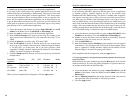
EtherFast
®
Cable/DSL Routers
Bridge - A device that interconnects different networks together.
Broadband - A data-transmission scheme in which multiple signals share the
bandwidth of a medium. This allows the transmission of voice, data, and video
signals over a single medium. Cable television uses broadband techniques to
deliver dozens of channels over one cable.
Browser - A browser is an application program that provides a way to look at
and interact with all the information on the World Wide Web or PC. The word
“browser” seems to have originated prior to the Web as a generic term for user
interfaces that let you browse text files online.
Cable Modem - A device that connects a computer to the cable television net-
work, which in turn connects to the Internet. Once connected, cable modem
users have a continuous connection to the Internet. Cable modems feature asym-
metric transfer rates: around 36 Mbps downstream (from the Internet to the
computer), and from 200 Kbps to 2 Mbps upstream (from the computer to the
Internet).
CAT 3 - ANSI/EIA (American National Standards Institute/Electronic
Industries Association) Standard 568 is one of several standards that specify
“categories” (the singular is commonly referred to as “CAT”) of twisted pair
cabling systems (wires, junctions, and connectors) in terms of the data rates that
they can sustain. CAT 3 cable has a maximum throughput of 16 Mbps and is
usually utilized for 10BaseT networks.
CAT 5 - ANSI/EIA (American National Standards Institute/Electronic
Industries Association) Standard 568 is one of several standards that specify
“categories” (the singular is commonly referred to as “CAT”) of twisted pair
cabling systems (wires, junctions, and connectors) in terms of the data rates that
they can sustain. CAT 5 cable has a maximum throughput of 100 Mbps and is
usually utilized for 100BaseTX networks.
CAT 5e - The additional cabling performance parameters of return loss and far-
end crosstalk (FEXT) specified for 1000BASE-T and not specified for
10BASE-T and 100BASE-TX are related to differences in the signaling imple-
mentation. 10BASE-T and 100BASE-TX signaling is unidirectional—signals
are transmitted in one direction on a single wire pair. In contrast, Gigabit
Ethernet is bi-directional—signals are transmitted simultaneously in both direc-
tions on the same wire pair; that is, both the transmit and receive pair occupy the
same wire pair.
93
Instant Broadband
™
Series
92
Appendix B: Glossary
10BaseT - An Ethernet standard that uses twisted wire pairs.
100BaseTX - IEEE physical layer specification for 100 Mbps over two pairs of
Category 5 UTP or STP wire.
1000BASE-T - Provides half-duplex (CSMA/CD) and full-duplex 1000 Mbps
Ethernet service over Category 5 links as defined by ANSI/TIA/EIA-568-A.
Topology rules for 1000BASE-T are the same as those used for 100BASE-T.
Category 5 link lengths are limited to 100 meters by the ANSI/TIA/EIA-568-A
cabling standard. Only one CSMA/CD repeater will be allowed in a collision
domain.
Adapter - Printed circuit board that plugs into a PC to add to capabilities or con-
nectivity to a PC. In a networked environment, a network interface card (NIC)
is the typical adapter that allows the PC or server to connect to the intranet
and/or Internet.
Auto-negotiate - To automatically determine the correct settings. The term is
often used with communications and networking. For example, Ethernet 10/100
cards, hubs, and switches can determine the highest speed of the node they are
connected to and adjust their transmission rate accordingly.
Backbone – The part of a network that connects most of the systems and net-
works together and handles the most data.
Bandwidth - The transmission capacity of a given facility, in terms of how
much data the facility can transmit in a fixed amount of time; expressed in bits
per second (bps).
Bit – A binary digit. The value—0 or 1—used in the binary numbering system.
Also, the smallest form of data.
Boot – To cause the computer to start executing instructions. Personal comput-
ers contain built-in instructions in a ROM chip that are automatically executed
on startup. These instructions search for the operating system, load it, and pass
control to it.
Bottleneck – A traffic slowdown that results when too many network nodes try
to access a single node, often a server node, at once.


















